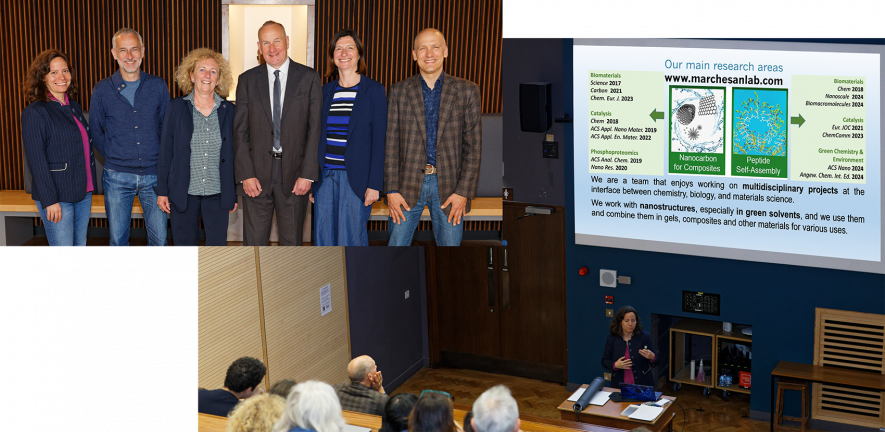
The delegation from the University of Trieste included Prof. Barbara Milani, Rector’s Delegate for International Affairs, Prof. Elisabetta Lengo, and Prof. Silvia Marchesan, who works on supramolecular chemistry at the Department of Chemical and Pharmaceutical Sciences at the University of Trieste. On this occasion, Prof. Marchesan delivered a seminar titled “Short-Peptide Self-Assembly: From Design to Applications in Catalysis, Therapy, and Beyond”, highlighting new directions in supramolecular chemistry and biomedical applications.
A major area of collaboration has focused on peptide-based coordination cages, closely linked to the themes of Prof. Marchesan’s research group. Researchers from Trieste and Cambridge have jointly developed systems in which short peptides are incorporated into metal–organic cages, endowing them with new and useful properties, such as the ability to form gels. This work points towards exciting future applications in catalysis, drug delivery, and biomaterials.
By supporting the exchange of researchers between the two universities, the partnership has led to exciting discoveries and important publications in leading scientific journals, including:
- Embedding and Positioning of Two FeII4L4 Cages in Supramolecular Tripeptide Gels for Selective Chemical Segregation;
- Metal Ions Trigger the Gelation of Cysteine‐Containing Peptide‐Appended Coordination Cages;
- Cages meet gels: Smart materials with dual porosity.
Moreover, collaborative work with Prof. Marchesan and Dr Barbara Rossi at the Elettra Synchrotron, near the University of Trieste, enabled the Raman characterisation of unusual new capsules containing clusters of silver atoms at polyhedral vertices. Their advanced techniques confirmed that the silver clusters were persistent, and not merely artefacts of crystallisation, opening new avenues in materials chemistry. This collaboration resulted in two key publications:
-
Two (AgI3I)4L4 cages elucidate the rules for silver-cluster vertex design;
- A Double‐Walled Tetrahedron with AgI4 Vertices Binds Different Guests in Distinct Sites.
Most recently, Simone Zucchelli, a PhD student from Prof. Paola Posocco’s group at the Department of Engineering and Architecture in Trieste, visited Cambridge to computationally explore the dynamics of a novel knotted host molecule. This has resulted in a paper just accepted by Nature Synthesis, titled: Knotting a tetrahedral cage mechanically locks guests inside.
Prof. Jonathan Nitschke, who leads this partnership at the Department of Chemistry at the University of Cambridge, stated: “I'm particularly enthusiastic because I've benefited greatly from collaborations with investigators at Trieste. By bringing together researchers from different backgrounds, this collaboration has enabled discoveries that would not have been possible otherwise. It has also provided valuable experience for all involved, enhancing skills, techniques, and international connections.”
Thanks to the strong foundation laid by the MoU, the collaboration continues to deepen, opening new opportunities for innovative scientific work.
Additional reading:
Self-healing glass from a simple peptide — just add water.
Chirality Effects on Peptide Self-Assembly Unraveled from Molecules to Materials: Chem.

